Last Updated: 07/10/2025
How Much to Feed a Puppy
Getting a new puppy is an exciting time with lots of info to learn. Find out how much to feed your puppy in our Vet-written guide.
Author: Dr Carla Paszkowski BVSc (Hons)
Reading Time: 17 minutes - medium read
New puppy owners often find themselves overwhelmed with the myriad of responsibilities that come with their new pet. One of the most pressing concerns is ensuring their puppy gets the right amount of nutrition.
Feeding a puppy too little can hinder its growth and development, while overfeeding can lead to obesity and health issues. With so many different breeds, sizes, and individual needs, it's easy to feel lost in the maze of feeding guidelines.
In addition, what your puppy eats in the first year of life has a direct effect on their growth, skeletal development and immune system. It also influences their risk of developing obesity later in life.
In this article, we will discuss what to feed your puppy, as well as provide clear and concise guidelines on how much and often to feed your puppy based on age, weight, and activity level, ensuring they grow up healthy and strong.
For info about puppy desexing, diets, worming, and more, check out Dr. Teagan's Complete New Puppy Guide. And don't forget, our Vet Squad are ready to help with any questions you have!
In this article
- Importance of Puppy Nutrition
- What is the difference between 'puppy' and 'adult dog' food?
- How Much to Feed a Puppy?
- How Often to Feed a Puppy
- When should I transition my puppy onto adult food?
- How To Introduce a Puppy to a New Food
- What is the Best Food Bowl for Puppies?
- What is the Best Puppy Treat?
- Special Considerations
- FAQs
The Importance of Puppy Nutrition

Feeding Puppies From Birth To Weaning
Feeding puppies from birth to weaning is a critical stage that sets the foundation for their future health and development. During the first few weeks of life, their mother's milk provides essential nutrients and antibodies that help puppies grow and develop. It's crucial for newborn puppies to nurse frequently, as their tiny stomachs can only hold a small amount of milk at a time.
For orphaned or supplemented puppies, bottle-feeding is necessary, using a specialised puppy milk replacer like DiVetelact and following the specific product's guidelines for feeding frequency and quantity based on their age and weight. Daily weight monitoring is essential during this stage, as it helps ensure that puppies are gaining weight steadily, which is a sign of healthy growth.
For more information on feeding puppies from birth through to weaning, read through our Newborn Puppy Care Guide.
Feeding Your Pup After Weaning
Puppies can start being introduced to foods other than their mothers milk from as early as 3 weeks. It is best to start puppies on a wet food diet with a soft, mousse-like texture to make the transition onto solid food easier. When introducing wet food for the first time it is best to mix with your puppy's regular milk. Whenever dry food is first introduced, it is best to soak dry food in warm water, or puppy milk replacer, to allow the kibble to soften and make it easier for pups to eat.
Puppies may be unsure of new foods at first, and will generally not eat sufficient amounts of solid foods to sustain themselves until around 6-8 weeks of age, so puppies will continue to feed off their mother's milk during this time. 6-8 weeks of age is considered the minimum acceptable age for puppies to removed from their mother.
What your puppy eats in the first year of life has a direct effect on their growth, skeletal development and immune system:
Overfeeding nutrients can lead to obesity, joint problems, and skeletal abnormalities such as hip dysplasia.
Underfeeding can lead to malnourishment, stunted growth, weak bones, poor immune system, and developmental problems.
Premium puppy food has the optimal balance of energy, protein, fat, calcium and phosphorus to help your puppy grow and develop at the right rate. It is also highly digestible which is good for a sensitive stomach. Depending on your puppy's breed and size they will need to stay on puppy food from 10 to 24 months of age.
Check out our Vet's recommended foods for different breed sizes in our Best Puppy Food Guide.
What is the difference between 'puppy' and 'adult dog' food?

Puppy diets are specifically formulated with a higher concentration of protein, fat, and energy than 'adult dog' varieties, to support rapid growth. They also have higher levels of calcium and phosphorus, although these nutrients are lower for large breed pups to reduce the risk of skeletal abnormalities.
1. Energy needs are greater for puppies, as they are growing every day. This means that calorie content is higher in puppy food. The optimal calorie content for your puppy varies based on breed, size, and activity level - for instance, large breed puppy food contains a lower calorie content than small breed puppy food to ensure a slower, steadier growth rate that allows their larger bones to develop properly.
2. Protein is also higher in puppy food. A puppy's need for protein is highest immediately after weaning, and decreases slowly after this. AAFCO recommends puppy food contain a minimum of 22.5% crude protein on a dry matter basis, or 56.3 grams per 1000kcal, whereas adult dogs only require a minimum of 18% on a dry matter basis, or 45 grams per 1000kcal.1
3. Fat is also higher in puppy food than adult food. Fat is a source of essential fatty acids and is a concentrated source of energy, although too much can lead to obesity and developmental orthopaedic disease. AAFCO recommends puppy food contain a minimum of 8.5% crude fat on a dry matter basis, or 21.3 grams per 1000kcal, whereas adult dogs only require a minimum of 5.5% on a dry matter basis, or 13.8 grams per 1000kcal. Puppies also have a higher requirement of certain fatty acids, such as linoleic acid, EPA and DHA. 1
4. Vitamin & Mineral requirements are different for puppies compared to adults. Calcium and phosphorus are particularly important, and required in higher quantities than adults. However the need for these nutrients differs greatly between large and small breed puppies. Large breed puppies are extremely sensitive to over-feeding calcium and can develop skeletal abnormalities if this occurs. Thus, AAFCO has established a 'minimum' calcium level of 1.2% on a dry matter basis for puppies and 0.5% for adults, as well as a 'maximum' level - large breed puppy food should not exceed 1.8% calcium, whereas small and medium breed puppy food should not exceed 2.5%.
You're probably thinking that calculating exactly how much of each nutrient your puppy needs sounds rather complicated. The good news is, with commercial pet food, the hard work has already been done for you. Every pet diet comes with feeding guidelines printed on the packaging. Read more about this below.
For more information, check out our guide to Switching from Puppy to Adult Dog Food.
How Much to Feed a Puppy?
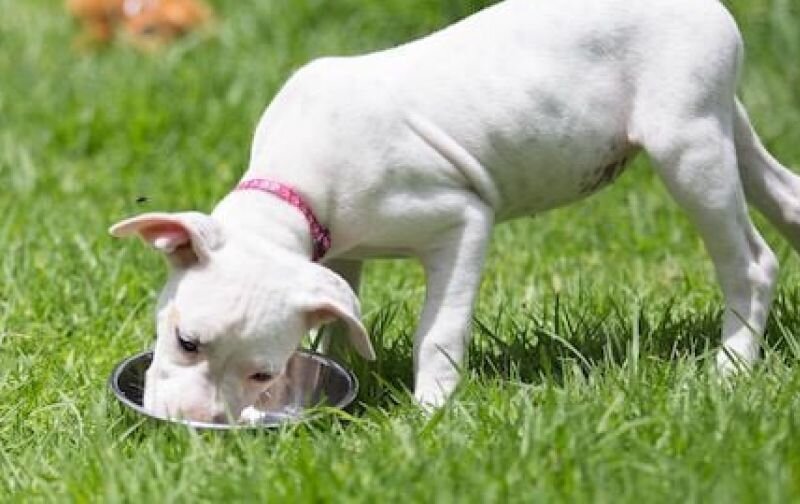
Follow the feeding guidelines
When determining how much food to give your little one, it's important to realise that not every puppy food is the same. Different diets can vary in their energy density, bioavailability of ingredients, or water content, which means that you might need to feed more or less than other diets depending on the brand.
This is why it's so important to follow individual feeding guidelines. Every commercial pet diet should have a feeding guideline printed on the packaging, so all you have to do is feed the amount recommended for your puppy's age and expected weight.
What is a feeding guideline?
Feeding guidelines are typically presented as easy-to-read tables printed on the back of pet food. To accommodate for puppies of different breed sizes, the table typically marries up your pet's age with their expected adult weight.
Let's take the following feeding guideline, taken from ADVANCE Medium Puppy Dry Food:
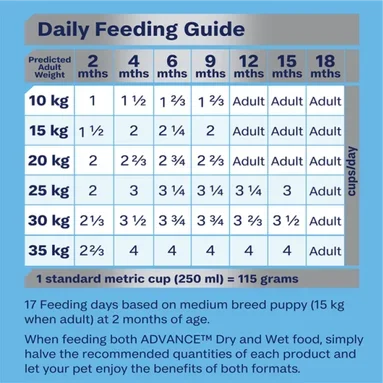
This feeding guideline shows how many cups of dry food per day you should feed, based on how old your puppy is (indicated by the top row) and how heavy they are expected to be as an adult (indicated by the left column). To help show you how this table works, let's look at the following examples:
Example 1: Cavoodle. Let's say your puppy is an 8 week (2 month) old medium sized Cavoodle. You were told by their breeder that their mother and father weighed approximately 10kg, so you are expecting them to weigh the same. Based on this table, your puppy should have 1 cup per day. When they are 6 months old, you should increase this to 1 and 2/3rds per day.
Example 2: Golden Retriever. For another example, let's pretend your puppy is a 16 week (4 month) old female Golden Retriever. You aren't sure about the parents, but know that your puppy is 'average' sized for a female Golden Retriever and your vet has advised they will be around 25kg as an adult. Based on this table, you should be feeding 3 cups per day.
What if I don't know my dog's expected adult weight?
Unfortunately, most feeding guidelines for puppies work off the 'expected weight' they will be as an adult. But in many cases, it is not possible to know this. If your dog was a rescue puppy, an unknown breed mix, or you never saw their parents, it can be very hard to predict what their expected adult weight will be. There are a number of ways you can do this:
1. Look up their breed online. If you know your dog's breed, look up their expected adult weight online. Of course, there is a lot of variation in size within one breed, but at least it is a good place to start.
2. Use a 'dog size' calculator. This is a good option if you don't know your dog's breed. Many dog size calculators are available online, and use your puppy's current weight and age to estimate their full-grown size. The growth charts on this page are a great place to start.
3. Ask your vet for guidance if you still aren't sure, or if you don't know how old your puppy is. Your vet will know how to age your pup, and should be able to give you an estimate of their expected adult weight. (And they can even find out your dog's breed mix with a DNA test if you want!)
What size cup should I use to measure puppy food?
Most people use 'cups' to measure their dog's food, because weighing food can be tricky - plus, many pet food brands give their feeding guide recommendations based on 'cups per day'. Most feeding guidelines outline how many grams of pet food make up '1 cup' (see the Advance example above!)
However, not every puppy food brand uses the same measuring cup size. Pet stores and veterinary clinics may be able to provide you with a brand specific cup (for example a 'Royal Canin' cup), but of course this can be hard to source.
This means you may need to use kitchen scales to weigh the first 'cup' and determine how many grams this translates to, in order to properly interpret feeding guidelines.
What if I feed a mixture of wet and dry food?
Feeding both wet and dry food is a great idea - it can help keep your dog's diet varied, promotes hydration, and helps keep them interested in the food.
The easiest way to work out how much food your puppy needs if you are feeding both wet and dry is to halve the daily recommended amount of each. Half of each 'recommended' amount for two different diets means you will feed one 'complete' daily meal. This can also be done with other fractions to make it 'one complete daily amount' - for example, 1/3rd wet and 2/3rds dry, or 1/4 wet and 3/4 dry, etc.
How Often to Feed a Puppy

Now that you know what type of food and how much to feed your puppy per day, the question is: how many 'meals per day' should you divide this into?
Due to their small tummies but high metabolic rate, puppies need small meals fed frequently, rather than large meals spaced apart. Big meals in little tummies can result in bloating, slow digestion, and discomfort. As your puppy ages, the number of meals per day can gradually be decreased.
How many times a day should you feed a puppy?
- Weaning to 3 months of age: feed 4 times per day
- 3-6 months of age: feed 3 times per day
- 6-12 months of age: feed twice per day
- 12 months of age onwards: continue feeding twice per day
What time of day should you feed a puppy?
Ideally you should feed your puppy between the hours of 7am and 6pm. Ensuring their final meal is around 6pm means that they will have time to fully digest the food before bedtime, and may also reduce the incidence of nighttime accidents.
Why is a consistent routine important?
A consistent mealtime routine is important for a number of reasons:
1. Digestive health: Regular feeding times aid in digestion and bowel regularity. Small meals fed frequently can help reduce bloating and discomfort that can result from large meals.
2. Mental and behavioural benefits: dogs thrive on routine, and are less likely to suffer from anxiety if they have a stable, consistent schedule. This means that regular predictable mealtimes can help reduce anxiety and problem behaviours.
3. Avoids overfeeding or underfeeding: Staying on top of a consistent mealtime schedule can help you monitor your pup's food intake, and ultimately makes it easier to ensure they receive the correct amount of nutrition per day.
When should I transition my puppy onto adult food?
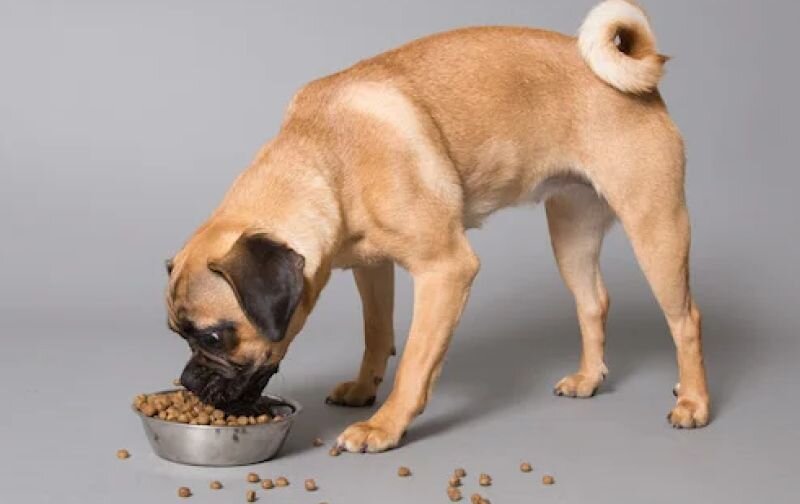
Typically, pets reach their full growth and should transition onto an 'adult' variety food around the following ages:
How To Introduce a Puppy to a New Food
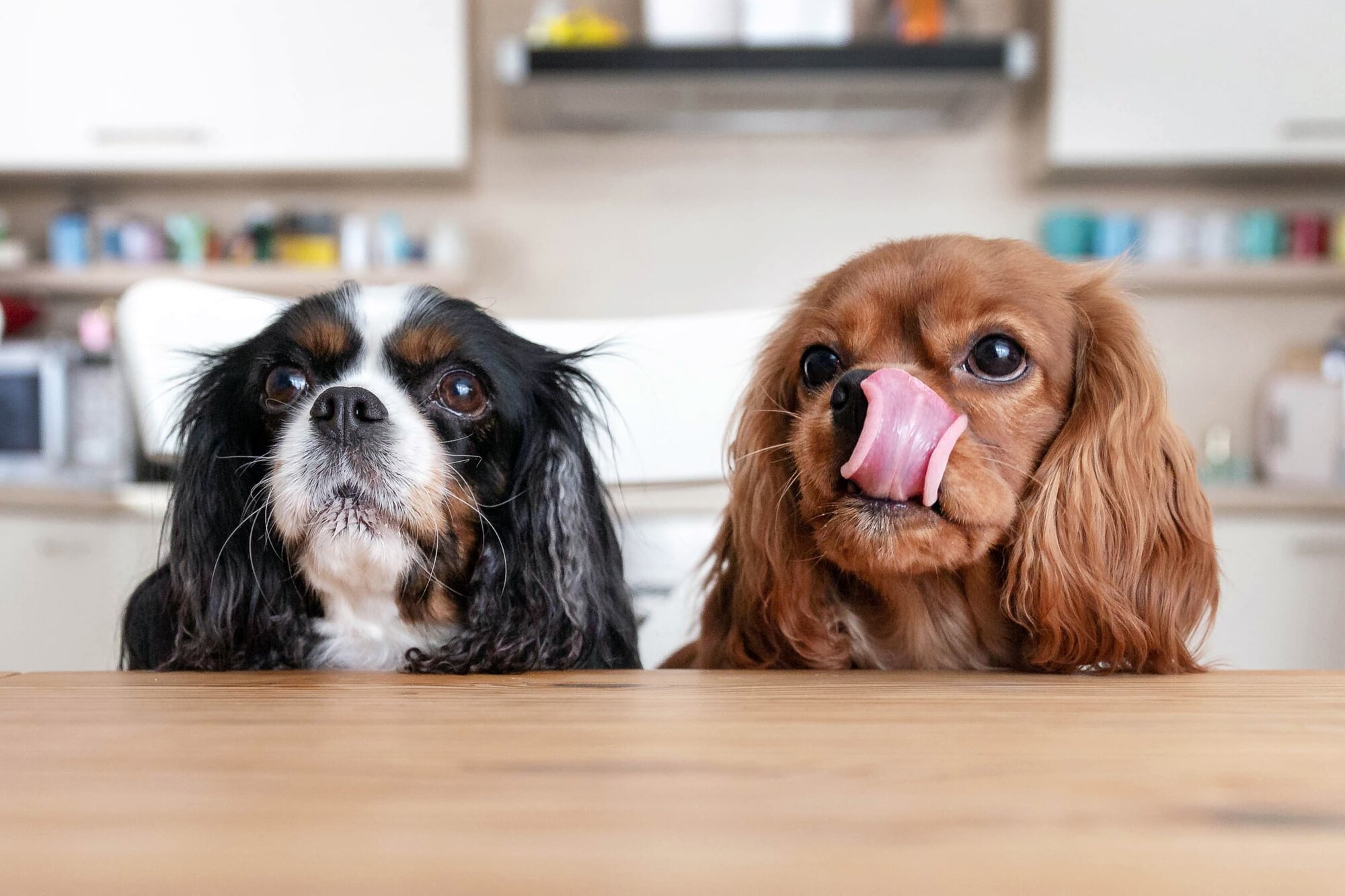
When you first bring your puppy home, it is best to start feeding them the food that they were eating at their previous home. Sudden changes in diet can result in tummy upsets leading to diarrhoea or vomiting, and should be avoided if possible.
Once your puppy has settled into their new home, they can be transitioned to the puppy diet of your choice, over a 1 week period.
How to transition your puppy from one diet to another:
Day 1-2: Mix 25% of the new food with 75% of the old food
Day 3-4: Mix 50% of the new food with 50% of the old food
Day 5-6: Mix 75% of the new food with 25% of the old food
Day 7 onwards: 100% new food
Looking for more information? Read our veterinary written article How to introduce a new food to your pet.
What is the Best Food Bowl for Puppies?
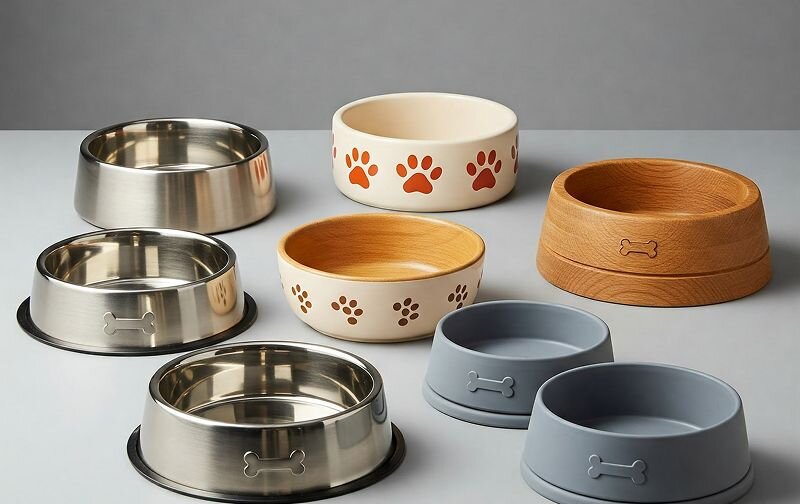
While it may be tempting to use any old container that you have at home, it is best to invest in a safe, pet approved bowl. This is especially important if you have a puppy in the house as cheap plastic can easily break and can be dangerous if swallowed.
Choosing the right bowl for your pet is more than picking out your favourite colour. Factors like material, design or functionality are important too!
Ceramic Bowls are heavy and offer greater stability than a plastic or stainless steel bowl however be careful not to drop this one! If your pet has a habit of tipping over their bowl or has difficulty keeping it still, this could be the solution you're looking for. Try to avoid purchasing an unglazed ceramic bowl as it is highly porous and will require regular scrubbing to get rid of any nasty bacteria.
Stainless Steel Bowls have earned the title of "vet favourite" as they are easy to keep clean and disinfect. Stainless Steel bowls are sturdy, durable and safe to use around teething pups.
Plastic Bowls are generally a more cost effective option than ceramic or stainless steel. High quality plastic is quite durable however can be difficult to keep clean as scratches from general wear and tear can become a breeding ground for nasty bacteria. It's best to avoid plastic bowls if you have chewing puppies in the house.
Anti Gulp Feeder Bowls have a unique maze-like structure of internal ridges which helps slow down meal time for pups that are natural gluttons. Eating or drinking too quickly can cause painful or improper digestion and may lead to bloat, a life threatening condition.
Interactive Dog Toys: Consider ditching the bowl and go for an interactive toy instead. Toys such as the KONG Wobbler dispense food while providing environmental enrichment, to help keep your pup mentally stimulated and avoid boredom.
What is the Best Puppy Treat?
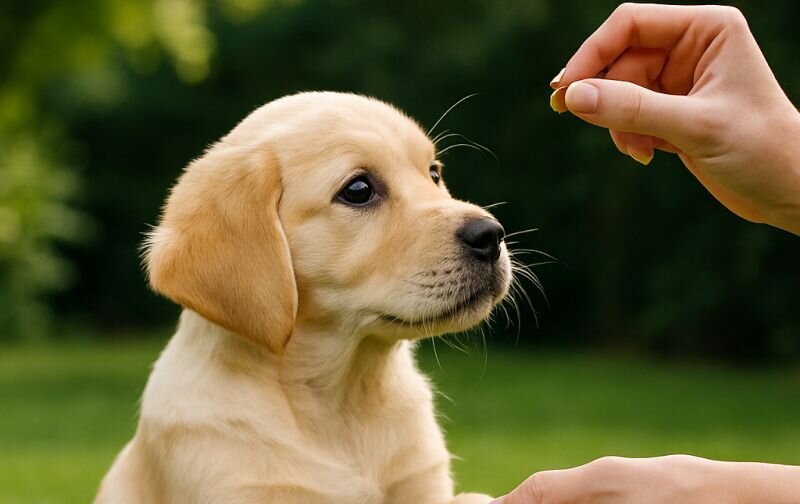
Treats are a great way to bond with your puppy and are an essential tool in teaching basic obedience and manners.
A good puppy treat should be:
- Delicious! Make sure it's something extra special that your pup doesn't normally eat
- Soft and easy to chew; baby teeth are not as strong as adult teeth, plus teething can make crunchy treats uncomfortable for some pups
- Mild on sensitive little tummies
Check out our Vets recommendations for the Best Puppy Treats.
Special Considerations
There may be some instances where a puppy has unique feeding requirements and the above guidance may not apply. Illnesses, allergies, and infections may change the feeding requirements of your puppy.
Allergies and food sensitivities
Food allergies are responsible for approximately 10% of allergy cases in dogs, ranked third after flea allergy and atopic dermatitis. Food allergies may present as pruritis (severe itching of the skin), and/or gastrointestinal signs such as diarrhoea, flatulence, vomiting and colitis. When a true food allergy is present, the most common causal allergens have been demonstrated to be beef (34% of food allergies), dairy (17%), chicken (15%), wheat (13%), and lamb (14.5%).2
If you are curious if your puppy has a food allergy, read our guide to How to Tell if Your Dog has a Food Allergy, and talk to your vet about completing an elimination diet or swapping to a 'sensitive' puppy food.
Dogs at risk of GDV and Bloat
Gastric Dilation and Volvulus (GDV), also know as 'bloat', refers to a life-threatening condition in which the stomach fills up with gas, fluid, or food, and becomes enlarged and dilated. Large breed puppies with deep chests such as the Great Dane, German Shepherd, and Dobermann are particularly prone to GDV.
Dogs at a high risk of developing GDV, or who have experienced it in the past, may need to be fed slowly, in small portions. No more guzzling big bowls of food in one go! Puzzle feeders and slow feeding bowls can work incredibly well to not only slow down your dog's eating but also keep them occupied.
Frequently asked questions
Properly nourishing your puppy is fundamental to their lifelong health and development. It's essential to select a high-quality puppy food appropriate for their breed size and to follow the feeding guidelines on the packaging, adjusting for a mix of wet and dry food if desired.
Establish a consistent routine of frequent, smaller meals, gradually reducing the frequency as they grow. Always transition to new foods slowly to avoid digestive upset.
By providing the correct nutrition in the right amounts, you set the foundation for your puppy to grow into a strong, healthy, and happy adult dog.
References
AAFCO Methods for substantiating nutritional adequacy of dog and cat foods, https://www.aafco.org/wp-content/uploads/2023/01/Model_Bills_and_Regulations_Agenda_Midyear_2015_Final_Attachment_A.__Proposed_revisions_to_AAFCO_Nutrient_Profiles_PFC_Final_070214.pdf (2012).
Mueller, R.S., Olivry, T. & Prelaud, P. Critically appraised topic on adverse food reactions of companion animals: common food allergen sources in dogs and cats, https://bmcvetres.biomedcentral.com/articles/10.1186/s12917-016-0633-8, BMC Vet Res 12, 9 (2016).
Further Reading
Want to read more? Check out our other articles:
How Much Should You Feed Your Pet
History
Our experts continually monitor the health and wellness space and we update our articles when new information becomes available.
Tue 22 Jul 2025
Edited by Dr Gillian Hill BVSc (Hons)Dr Carla Paszkowski BVSc (Hons)
Veterinarian
Dr. Carla graduated from the University of Queensland in 2013 with a Bachelor of Veterinary Science and worked for a number of years in small animal clinics across South East Queensland. While Carla enjoys most facets of clinical veterinary work, she holds a special passion for feline medicine, pocket pets, and nutrition.

